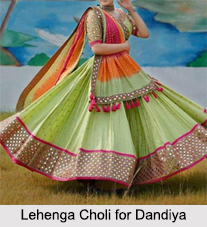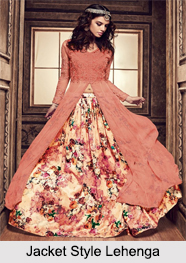 Ghagra Lehenga Choli is a combination of long skirt worn, with flair towards the bottom which is topped off by a long or short-length beautiful embroidered Indian blouse. The whole attire is complimented with a Dupatta, which is a cloth-piece, passed around the head, and mostly around the neck, to envelop the front upper portion. The ghagra or lehenga resembles flowing robes and covers from the waist to the ankles. These opulent Indian costumes, both the Ghagra and Choli, are made from exquisite matching shades and in gorgeous designs.
Ghagra Lehenga Choli is a combination of long skirt worn, with flair towards the bottom which is topped off by a long or short-length beautiful embroidered Indian blouse. The whole attire is complimented with a Dupatta, which is a cloth-piece, passed around the head, and mostly around the neck, to envelop the front upper portion. The ghagra or lehenga resembles flowing robes and covers from the waist to the ankles. These opulent Indian costumes, both the Ghagra and Choli, are made from exquisite matching shades and in gorgeous designs.
Designs and Materials of Ghagra Lehenga Choli
Rich fabric such as silk, cotton, khadi, georgette, crape, net, satin, brocade and chiffon is employed to create the elegant Ghagra Lehenga Choli. The outfit is preferred by the Indian women considering the elaborateness of designs. Each set of Lehenga-Choli presents certain distinctive. Furthermore, the distribution of design and patterns differ from one Lehenga-Choli to another. The shimmering embroidery designs of Lehenga-Choli Dupatta, ranges from mirror work, ariwork, Kundan-embroidery, beads work, Zardozi embroidery, Zariwork. Zardozi is a Persian form of embroidery, done with gold and silver thread, having the Indian name of Zari.
A fine blend of tradition with modern novelty can create a Lehenga in shot-colours such as a base reflecting two colours, one intermingling with the other. Again there can be viewed a medley of Zardozi with butawork. Fabulous mix and match drapery is the prime attraction in the present society. Moreover, Ghagra Lehenga Choli is expectedly associated with beautiful accessories, like gold, Kundan jewelry, diamond or gem-studded ornaments.
Occasions of Ghagra Lehenga Choli
Ghagra Lehenga Choli is considered to be a traditional Indian Wedding Dress. It projects the most glamorous and most colourful wedding dresses. The ghagra or Lehenga as a wedding dress are available in glamorous colours such as red with intricate designs and embroidery. It is preferred as the bridal wear among most of the communities in India. Furthermore, the dress is worn during various festivals such as Diwali, Navaratri or other Hindu religious functions.
 Types of Ghagra Lehenga Choli
Types of Ghagra Lehenga Choli
Ghagra Lehenga Choli is the traditional clothing of women from Indian Subcontinent, notable in Indian states of Rajasthan, Gujarat, Madhya Pradesh, Uttar Pradesh, Bihar, Haryana, Punjab, Himachal Pradesh, Uttarakhand, Jammu and Kashmir, as well as in Nepal. The gorgeous apparel Ghagra Lehenga-Choli has become the daily costume of the ethnic tribe of India, the Banjara, and the beautiful Rajasthani women. Its majestic get-up, outstanding splendour continues to enamour the pretty Indian women over generations. The classicism of Indian fashion is identified in the sophisticated craftsmanship and quiet and simple elegance of the Ghagra Lehenga Choli. This attire reflects the ancient tradition as well as the ethnicity of the Indian culture. Thus, Ghagra Lehnega Choli has become the trend of the present Indian society. There are certain types of Ghagra Lehenga Choli according to style, design, embroideries and materials.
Sharara: The Sharara is a three-piece outfit with flared pants for lowers, with a join at or below the knee level, generally worn to weddings. The skirt-like outline below the knee is heavily flared (also called the trumpet skirt) and resembles the shape of an umbrella. The Sharara is of floor-sweeping length (farshi) and is teamed with a Kurti and one or two Dupattas, the other outfits of the three-piece attire. When worn with two Dupattas, one is used to drape the shoulders while the second one is used as a veil.
Gharara: Emerging from the ethnic soils of Lucknow, Gharara (also spelled as garara) is the most traditional form of outfit comprising a short or knee-length kurti, a dupatta, teamed with a pair of wide-legged palazzo pants typically ruched at the knee with some intricate design giving the pant a broad flare. It is also a common ethnic wear worn by the Muslim women of North India.
Lacha: Lacha is a long flared skirt with adorned hemline, worn with a matching blouse. They are available in different fabrics like Brocade, Chiffon, Net, Crepe, Satin, Silk, Georgette, etc. A lively and gorgeous touch is brought in to this charming dress with a variety of Beadwork, Zari work, Mirror work that is generously layered to perfection on this attire.
Rajasthani Ghagra: The Rajasthani Ghagra is a kind of pleated skirt that is long and embroidered and worn as the lower portion of a Ghagra kanchli or Choli (blouse). It is tied around the waist and held by a drawstring. It evolved from Bhainivasani, which has its roots in the Antariya.

Layered Lehenga: A Layered Lehenga has several layers of materials on the skirt, forming flares of different sizes from top to bottom of the skirt. Layered Lehengas are dresses that have been inspired from the traditional Indian dress lehenga or ghagra, which has been modernized by adding multiple layers of fabric.
Sari Style Lehenga: The lehenga style saree or the lehenga saree is a fusion of two ethnic Indian outfits merged into one beautiful, easy-to-wear garment. With a skirt that brings the lehenga element of the dress into play, the pallu refers to the saree whereas the top-wear can be inspired from either. Emerging as the latest party wear outfit, lehenga style sarees offer the best of both worlds, the elegance of saree and the convenience of a lehenga.
The Lehenga has also imbibed and merged with modern influences and global trends. The lehenga style Saree is one of the latest Indian ethnic innovations doing the rounds that merge the saree and lehenga silhouette into one. The lower half comprises a ready-made sari with pleats, fall and drapes resembling the flared portrait of lehenga, with a zip or knot at the waist side for adjustments. The upper half of the attire has to be tucked and wrapped around once which resembles the pallu of the saree. The Anarkali Lehenga is another recent innovation that the Lehenga has undergone. In terms of fitting or silhouettes, lehenga cholis are designed in A-line, Straight cut, Umbrella cut and Fish cut or Mermaid cut silhouettes.





















